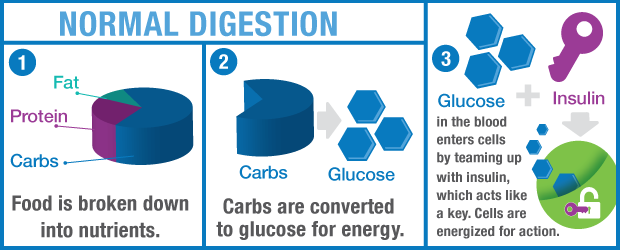Prediabetes – Is your blood sugar on the brink?
Category: Diabetes

Recently on a family trip, several people I visited mentioned that they had been diagnosed with Prediabetes. Most of the time when I had heard about diabetes, I’ve heard about Type 1 or Type 2 Diabetes. I have a pretty good grasp on Type 1 as our daughter was diagnosed with it. In Type 1, there is no choice but to use insulin as the pancreas is no longer functioning.
I decided to dig in and learn more about Prediabetes. As I read more, I realized Prediabetes really is “blood sugar on the brink.” My goal in writing this is to help you learn a bit more about it and share ways that you can start to reduce your risk of moving from normal blood sugar to Prediabetes or from Prediabetes to Type 2 Diabetes.
The first question is “What defines it?” As shown in the graphic below, it’s when blood glucose levels are above 100 but below 125 which is then considered to be Type 2 Diabetes.

As stated in the picture above “at this stage, you can delay or prevent diabetes.” I was surprised by the statistics below stating that 86 Million American adults – more than 1 out of 3 – have prediabetes. Also, 9 out of 10 people with prediabetes do not know they have it!
What are the symptoms?
The following symptoms of diabetes are typical. However, some people with prediabetes or type 2 diabetes have symptoms so mild that they go unnoticed.
Common symptoms of diabetes:
- Urinating often
- Feeling very thirsty
- Feeling very hungry – even though you are eating
- Extreme fatigue
- Blurry vision
- Cuts/bruises that are slow to heal
- Tingling, pain, or numbness in the hands/feet
It’s important that you get this checked by your health care provider if you notice these symptoms.
Here’s how your body processes glucose properly.

When it’s working correctly, the glucose will enter the cell to make your cells work great and give you nice balanced energy!
Diabetes risks rise when there is a deficiency in the ability to metabolize sugar and carbs due to increased insulin resistance and impairment in insulin production. Glucose teams up with insulin which acts as a key fitting into a lock to allow the glucose into your cells. But with insulin resistance, over time the insulin key cannot open the lock of the cell to get in properly. The pancreas makes more insulin, which increases insulin levels in the blood. Eventually, the pancreas produces far more insulin than normal and the cells continue to be resistant. As long as one can produce enough insulin to overcome this resistance, blood glucose levels remain normal. Once the pancreas is no longer able to keep up, blood glucose starts to rise, initially after meals, eventually even in the fasting state. Type 2 diabetes is now high risk.
What can you do?
Nutrition and Diet
W e often hear that “Carbs are bad” I encourage you to learn more about Carbohydrates because they do play a role in having good energy. The difference between choosing simple carbs versus complex carbs can often be tremendous.
e often hear that “Carbs are bad” I encourage you to learn more about Carbohydrates because they do play a role in having good energy. The difference between choosing simple carbs versus complex carbs can often be tremendous.
Have you ever eaten a high fat or high sugar meal only to find yourself falling asleep on the sofa? Or perhaps your acting hyper from the sugar and then your crabby?
Complex carbs usually contain some fiber that helps your blood sugar stay balanced. I hope you will enjoy this article on the ADA website called Make Your Carbs Count I’ve also found that having high quality protein included with each meal and snack can make a huge difference. Protein is the repairer of all the cells in our body so it’s important to get enough.
When it comes down to it, the basic goal for each of us if we wish to either keep our health or work on rebuilding is to eat a healthy diet. Here’s an article that will give you 6 building blocks for a healthy diet
Exercise
Whether you’re just starting to incorporate exercise into your daily routine or you’re looking to maintain a healthy and active lifestyle, here are 5 tips to keep you exercising to help keep you on track to meet your goals. Most of the articles I’ve read during this search have suggests about 150 minutes a week. I encourage you to make a start. If it’s 5 minutes a day, then ten- just keep working up – it will serve you well!
I feel like I just touched on the tip of the iceberg in this blog. Writing this leads me to inquire on other topics that will relate to this like Metabolic Syndrome and the Glycemic Index.
My hope is that these starting tips will start you on a path that will “bring your blood sugar back from the brink.”




One comment on “Prediabetes – Is your blood sugar on the brink?”
Comments are closed.